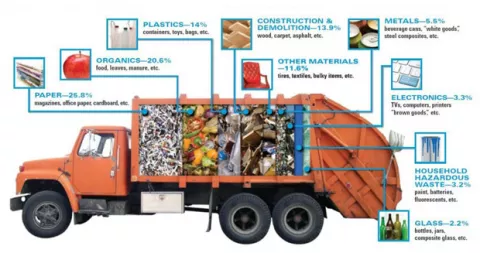
Kamikatsu, a small village in the mountains of Shikoku Island in south-west Japan, aims at being the country's first 'Zero Waste' community by 2020. And going by the pace of implementation so far, it seems that the Japanese' town is very much on the defined path to achieve the same.
Today in Kamikatsu, there’s no such thing such as 'Trash'. You won’t find a single garbage bin in any of the town’s homes, and there’s not a dump anywhere within driving distance. Instead, the resourceful residents must compost all waste from their food, and sort out other trash into 34 separate categories viz - plastic bottles, glass bottles, bottle caps, razor blades, Styrofoam, and various other paraphernalia to name a few.
What is Zero Waste?
'Zero Waste' in simpler words also means 'No waste'. A concept that follows a philosophy of redesigning resource life cycles so that all products are reused. The concept includes 'recycling' but goes beyond 'recycling' by taking a 'whole system' approach to the vast flow of resources and waste through human society.
'Zero Waste' maximises recycling, minimises waste, reduces consumption and ensures that products are made to be reused, repaired or recycled back into nature or the marketplace.
How did it all begin for Kamikatsu?
The small town with a total population of less then 2,000 (as of April 2015), took its first step towards the 'Zero Waste' movement some 30-odd years ago as the town built an incinerator after pressurised by the national government to stop burning rubbish in an open fire.
The model was, however, soon banned following health concerns about the dioxins it the plant produced. Not only did the town lose out by building a useless incinerator, but it lost money by having to pay large sums to use the facilities of a nearby town.
This forced the people of Kamikatsu to find an alternative solution. The town researched cases around the world and eventually focused on 'recycling'. As by 'recycling' the waste was turned into reusable products, hence thee was no trash sent to landfills and incinerators.
Degrees of waste separation
To recycle waste the 'waste' first needed to be separated into different categories.
The residents of Kamikatsu started with nine categories of waste separation, and over time by 2002, the number of categories grew to 34. It’s the largest number in Japan, and most probably in the world.
What is also significant is that all organic waste is managed within each household and recycled 100 per cent. Many residents own their farms and make their own fertiliser; others buy the local compost, 80 per cent of the cost is subsidised by the town office.
There are no garbage trucks, people take their waste to the town collection centre and separate it into the various categories by themselves.
Inside the centre, there are 60 different spaces and boxes which help and educate people on waste segregation. Each space or box is labelled to show where it will be recycled, what it will become and how much it will cost (or earn) in doing so.
All bottles, cans and even plastic food wrappers must be washed. Newspapers and magazines have to be piled into bundles. Anything in good condition ends up at a recycling store. Residents may drop off or take home whatever they like free of charge.
Current scenario
Data shows that Kamikatsu's recycling rate has risen from 55 per cent a decade ago to about 80 per cent today. This is based on the waste coming into the waste collection centre, not the waste in all households, which would make the per centage even higher. Five years after the scheme's inception an overwhelming 98 per cent of the population uses home composters, which cost a merely 3,000 yen with government subsidies.
The town also has a 'kuru-kuru' shop (“circular” in Japanese), where residents can bring in used items and take things home for free. It also has a 'kuru-kuru' factory, where local women make bags and clothes out of discarded clothes.
The town collection centre centre and these facilities are managed and operated by a local non-profit organisation called 'Zero Waste Academy'. The centre is visited not only by elementary and Junior High School's but also students and organisations from all over the world. The number of tourists to the town has seen a steady uptrend, to about 2,500 visitors per year as of 2014.
Way forward
The next step is to prevent waste production altogether. This should involve not only the residents from the town but also businesses, both in and out of the town, involved in material production and supply.
In 2015, the people of Kamikatsu created a roadmap for achieving 'Zero waste' by 2020. As mentioned at the beginning of the article, in working together and coming up with innovative solutions, Kamikatsu is very well on their way.
Wondering if Kamikatsu with a population of less than 2,000 is the sole town aiming for 'Zero Waste', then hold-on there are some prominent cites of UK and US too following suit - Italy's Capannori, Buenos Aires, Sweden and San Francisco to name a few.
Achieving 'Zero Waste' in big cities might seem impossible, but these cities have implemented plans that are getting them very close. Now it's time for the rest of the world to follow.



